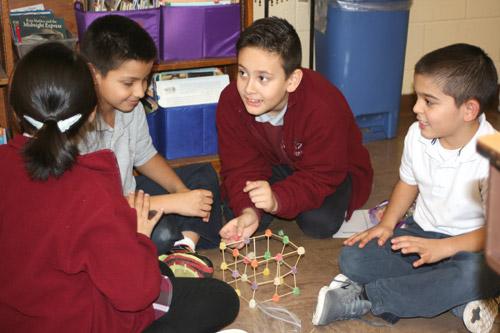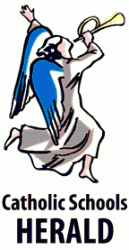

This school year, students have been protecting bees, fighting erosion in local streams and figuring out the answer to an age-old question — how does one stop the big bad wolf from blowing the three little piggies’ houses down?
It’s all part of an effort to incorporate STEM lessons into Catholic classrooms. STEM, an acronym for science, technology, engineering and math, is curriculum-based teachings that focus on those key areas with lessons that promote problem-solving and critical thinking.
Few American students are pursuing careers in STEM-centered fields, with the U.S. Department of Education citing “only 16 percent of American high school seniors are proficient in math and interested in a STEM career.” As a nation, the U.S. ranks 29th in math and 29th in science compared to other industrialized countries, according to ed.gov/stem. Only 29 percent of Americans rated K-12 education in STEM subjects as above average.
With STEM careers continuing to rise in the U.S. economy, Catholic schools in Arkansas are trying to stay ahead of the curve.
“Technology increases and changes faster than we can really get used to it. We’ve got to stay as cutting edge as possible,” said Kristy Dunn, principal at St. Theresa School in Little Rock. “We need to keep up-to-date on scientific concepts because that sector of the economy is in steady growth.”
St. Theresa’s implemented STEM this August, with lessons about once a month.
Projects have included a guest biologist from the Arkansas Game and Fish Commission teaching the students about turkeys, building habitats for stuffed animals for a zoo project, learning about dental hygiene through “America’s Tooth Fairy” curriculum presented by dental students at UAMS and aerodynamics projects in the upper grades.
“What I have found as a teacher is that my voice only carries so much weight. They need to hear and learn from other voices,” Dunn said. “When they hear from a Game and Fish biologist, I know it sparks them to think about what they want to do when they grow up, what God calls them to do with their lives.”
While the projects are driven by science, technology, engineering and math, the faith factor is always present in Catholic education, shown in Dunn’s favorite project thus far, “the big bad wolf one,” where students built structures to withstand about 10 seconds of a blowing hair dryer.
“It touched my heart because multiple groups chose to put a cross or symbol of faith on their building,” Dunn said. “It just shows how engrained the faith is in the children.”
Schools like Mount St. Mary Academy also have incorporated a variation called STEAM, which adds the art component. Art teacher Marianne Nolley said history’s great artists were also “at the same time discovering things in science.”
“I think art is in every subject,” Nolley said. “It’s a different way of looking at the world and encourages problem-solving.”
MSM students were awarded $10,000 in the Lexus Eco Challenge, a national STEM competition, for their project studying the declining bee population. The “HoneyBelles” six-member team, along with Nolley and biology teacher Marcella Melandri, created a garden at MSM with local flowers and plants to sustain the bee population. The money is split between the school, students who worked on the project and Nolley and Melandri. Each student used their strengths in designing the garden, creating items to sell for fundraisers and the science of how to sustain the bee population.
“Right now there is a lot of talk about science in school, how we need scientists. We need people to solve all these problems we have,” Melandri said. “I always tell my students you don’t have to have the cure for cancer to actually get to the cure for cancer. The more questions you have,” the more likely an answer will be found.
In the spring, MSM will find out if they are awarded the $30,000 grand prize for the project. The teachers said they are looking at ways to keep the garden and expand its use to other classes.
“I think for a long time we have segregated education into subjects. If you look at the Greeks and the Romans, one person taught about life,” Nolley said. “When we separate the subjects and don’t let them cross over each other,” students do not see the big picture.
At St. John School in Hot Springs, they take STEM even further with STREAM, adding religion prominently in the mix. Students have worked more than a decade on the Arkansas Game and Fish Stream Team project. Through the years, the program has evolved and added other concepts such as photography, writing, publishing and art. Students analyze the biological and chemical data of a nearby stream, take photos and write papers based on their experiences. The goal is to restore the stream, cutting out erosion.
“The students are out in the fields, out in the streams playing basically while doing science,” principal Angela Isaacs said. “We always talk about nature and God and his creations.”
This year, the school has implemented several more STEM projects, including middle school students designing models of buildings with various materials to see how each holds up to a simulated earthquake.
Like St. John, St. Paul School in Pocahontas has incorporated science with technology for years, but engineering has been the latest addition.
“I think it’s important to understand what an engineer does. I don’t think I had any idea as a kid what an engineer does,” said Christie Yemma, who teaches fifth- and sixth-grade math and science. “Engineering (is a part of) almost anything you’re interested in — outdoors and nature, big buildings, cars, toothbrushes, there’s engineering that’s involved.”
Yemma and fourth-grade teacher Abby Tyler were part of a grant workshop through Museum of Science in Boston called “Engineering is Elementary,” sponsored by Arkansas State University Rural and Delta STEM Education Centers.
Each lesson is built around a child somewhere in the world with a problem that needs an engineering solution. In Yemma’s fifth-grade class, they learned of a fictional Native American child in Washington State who lived on an Indian reservation and needed help cleaning up an oil spill in a river.
“They received testing materials, we were learning about the ecosystems at the time,” Yemma said, adding the students came up with the best solution factoring in cost and design.
St. Joseph School in Conway incorporates cross-curriculum learning throughout the grade levels, but for groups of eighth-grade girls, STEM-based learning extends beyond the classroom. For several years, Teri Breeding, St. Joseph High School counselor and academic dean, has taken groups of about four to 10 girls annually to the Girl Power in STEM conference at the University of Central Arkansas. The one-day conference allows the girls to get hands-on experience with STEM projects, talk with female professors as well as college students pursuing STEM-based careers.
“(One) guest speaker at the conference was an audiologist. She brought all the different instruments used to test a person’s hearing. One of the eighth grade girls in the group was actually wearing a hearing aid, so she was able to share her experience and even be the subject using the hearing test instruments,” Breeding said.
According to uca.edu, an estimated 300 girls throughout the state will attend the April 22 conference this year.
“I want my girls to know and understand that they can do anything they set their mind to,” Breeding said. “If they have a strength in the STEM disciplines and that is where their curiosity and passion lies, they need to go for it.”
Please read our Comments Policy before posting.
Article comments powered by Disqus Catholic communities preparing for total solar eclipse
Catholic communities preparing for total solar eclipse
 Papineau steps back after 20 years in parochial league
Papineau steps back after 20 years in parochial league
 St. Theresa girls’ basketball: there’s no ‘i’ in ‘team’
St. Theresa girls’ basketball: there’s no ‘i’ in ‘team’
 High school girls crochet breast prostheses for CARTI
High school girls crochet breast prostheses for CARTI
 2023 Year in Review: Community, teamwork prove pivotal
2023 Year in Review: Community, teamwork prove pivotal
 New season of ‘The Chosen’ delayed on streaming sites
New season of ‘The Chosen’ delayed on streaming sites
 Father Keller, oldest diocesan priest, a pro-life champion
Father Keller, oldest diocesan priest, a pro-life champion
 Vatican says abortion, surrogacy attack human dignity
Vatican says abortion, surrogacy attack human dignity
 Iowa basketball superstar supported by Catholic faith
Iowa basketball superstar supported by Catholic faith
 A Catholic You Want to Know: Joan Becker
A Catholic You Want to Know: Joan Becker
 Two gifts after Jesus’ death: Virgin Mary and Eucharist
Two gifts after Jesus’ death: Virgin Mary and Eucharist
 Why we have an altar, and not just a communion table
Why we have an altar, and not just a communion table
 Pope: Wars should be resolved through nonviolence
Pope: Wars should be resolved through nonviolence
 Living relationship with Jesus Christ in the Eucharist
Living relationship with Jesus Christ in the Eucharist
 Crosses: Adversities you could avoid, but are embraced
Crosses: Adversities you could avoid, but are embraced